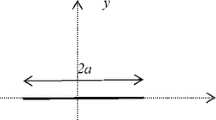Abstract
In this paper, we address some fundamental questions regarding the response of a crack to externally generated dislocations. We note that since dislocations that formed at external sources in the material must be in the form of loops or dipoles, the theory must be couched in terms of crack shielding in a plastically polarizable medium. There are strong analogies to dielectric theory. We prove two general theorems: (1) Dipoles formed in the emission geometry relative to a crack tip always antishield the crack and (2) when dipoles are induced during uniform motion of a crack through a uniformly plastically polarizable material, then the net shielding is always positive. We illustrate these general theorems with a number of special cases for fixed and polarizable sources. Finally, we simulate the self consistent time dependent response of a crack to a polarizable source as the crack moves past it. The results show that the crack is initially antishielded, but that positive shielding always dominates during later stages of configuration evolution. The crack may be arrested by the source, or it may break away from it, depending upon the various parameters (source strength and geometry, dislocation mobility, Griffith condition for the crack, etc.). The results indicate that the time dependence of crack shielding in the presence of a nonuniform density of sources will be very important in practical cases of brittle transitions in materials.
Similar content being viewed by others
References
J. Rice and R. Thomson, Philos. Mag. 29, 73 (1974).
I-H. Lin and R. Thomson, Acta Metall. 34, 187 (1986).
P. M. Anderson and J. Rice, J. Mech. Phys. Sol. 35, 743 (1987).
M. Ashby and J. Embury, Scripta Metall. 19, 557 (1985).
N. Narita, K. Higashida, and S. Kitano, Scripta Metall. 27, 1273 (1987).
T. Suzuki and H. Koizumi, unpublished report.
S.M. Ohr, Scripta Metall. 21, 1681 (1987).
M. Kanninen and C. Popelar, Advanced Fracture Mechanics (Oxford, 1985).
J. R. Rice, Mech. of Mater. 6, 317 (1987); J. R. Rice, D. E. Hawk, and R.J. Asaro, Int. J. Fract. 42, 301 (1990).
P. Mataga, L. Freund, and H. Hutchinson, J. Phys. Chem. Solids 48, 985 (1987).
S. Zhou and C. Lung, J. Phys.: Condens. Matter 1, 1, 2297 (1989).
J. D. Eshelby, Solid State Physics, edited by F. Seitz and D. Turnbull (Academic Press, New York, 1956), Vol. 3, p. 79.
R. Thomson, Solid State Physics, edited by D. Turnbull and H. Ehrenreich (Academic Press, New York, 1986), Vol. 39, p. 1.
J. Rice, J. Appl. Mech. 35, 379 (1968).
J. D. Eshelby, in Physics of Strength and Plasticity (The Orowan 65th Anniversary Volume, edited by A. Argon) (MIT Press, Cambridge, MA, 1969), p. 263.
Author information
Authors and Affiliations
Rights and permissions
About this article
Cite this article
Zhou, S.J., Thomson, R. Shielding of cracks in a plastically polarizable material. Journal of Materials Research 6, 1763–1772 (1991). https://doi.org/10.1557/JMR.1991.1763
Received:
Accepted:
Published:
Issue Date:
DOI: https://doi.org/10.1557/JMR.1991.1763



